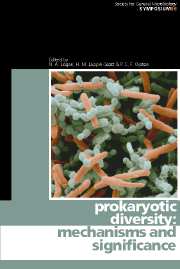Book contents
- Frontmatter
- Contents
- Contributors
- Editors' Preface
- Microbial diversity in the era of genomics
- Patterns in prokaryotic biodiversity
- A putative RNA-interference-based immune system in prokaryotes: the epitome of prokaryotic genomic diversity
- The significance of prokaryote diversity in the human gastrointestinal tract
- The genetics of phenotypic innovation
- Minimal genomes required for life
- Evolution of the core of genes
- Biogeographical diversity of archaeal viruses
- Is there a link between Chlamydia and heart disease?
- Unculturable oral bacteria
- Comparative genomics – what do such studies tell us about the emergence and spread of key pathogens?
- Spread of genomic islands between clinical and environmental strains
- Evolving gene clusters in soil bacteria
- Unusual micro-organisms from unusual habitats: hypersaline environments
- Genomic islands and evolution of catabolic pathways
- Horizontal gene transfer and its role in the emergence of new phenotypes
- Index
Minimal genomes required for life
Published online by Cambridge University Press: 06 July 2010
- Frontmatter
- Contents
- Contributors
- Editors' Preface
- Microbial diversity in the era of genomics
- Patterns in prokaryotic biodiversity
- A putative RNA-interference-based immune system in prokaryotes: the epitome of prokaryotic genomic diversity
- The significance of prokaryote diversity in the human gastrointestinal tract
- The genetics of phenotypic innovation
- Minimal genomes required for life
- Evolution of the core of genes
- Biogeographical diversity of archaeal viruses
- Is there a link between Chlamydia and heart disease?
- Unculturable oral bacteria
- Comparative genomics – what do such studies tell us about the emergence and spread of key pathogens?
- Spread of genomic islands between clinical and environmental strains
- Evolving gene clusters in soil bacteria
- Unusual micro-organisms from unusual habitats: hypersaline environments
- Genomic islands and evolution of catabolic pathways
- Horizontal gene transfer and its role in the emergence of new phenotypes
- Index
Summary
INTRODUCTION
Even the simplest unicellular organisms on Earth display an amazing degree of complexity. The question is whether such complexity is a necessary attribute of cellular life or whether, instead, cellular life could also be possible with a much smaller number of molecular components, in the form of what has been called a minimal cell (Luisi et al., 2002; Islas et al., 2004). The first step to envisage such a minimal cell implies the identification of the necessary and sufficient features of life, leading to a clear definition of what ‘life’ is in this context. This is an extremely complex question with a long tradition in theoretical biology because, in addition to the understanding of the essential properties of a living system, the definition of cellular life is also related to the debated issue of the origin of life, since in the early stages of cellular evolution cells must have been close to the simplest possible life forms. Nowadays, there is a reasonable degree of consensus in defining life as the property of a system that displays simultaneously three features: homeostasis, self-reproduction and evolution (Luisi et al., 2002).
Life can be considered an emergent property: it is a quality that arises from the assembly of non-living elements, properly arranged in space and time (Luisi, 2002). Therefore, to understand life it is necessary to understand first the main non-living components.
- Type
- Chapter
- Information
- Prokaryotic DiversityMechanisms and Significance, pp. 105 - 122Publisher: Cambridge University PressPrint publication year: 2006
- 1
- Cited by



